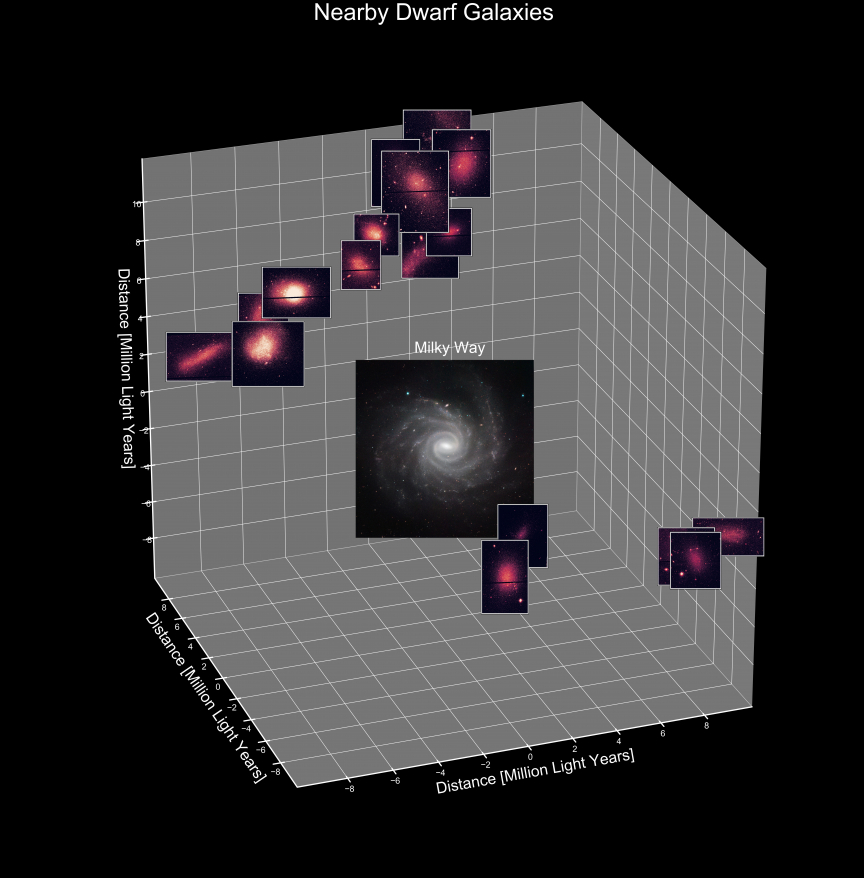Astronomers have found oddly synchronized star formation rates in 36 dwarf galaxies scattered around the Milky Way Galaxy. These dwarf galaxies all showed declines in star formation rates starting around six billion years ago, and then showed increased star formation rates starting three billion years ago and continuing into present time. The galaxies are significantly spaced out from each other, are located up to 13 million light-years apart, and reside in diverse cosmic environments. According to our conventional understanding of galactic growth, galaxies located more than one million light-years apart should display completely independent rates of star formation because the galaxies are not physically or mechanistically linked—in other words, what happens in one galaxy, should not affect that galaxy’s distant neighbors. The surprising results, conveyed in a recent study, suggest that a poorly understood, large-scale phenomenon must have provided new star-making fuel to the galaxies or otherwise triggered star formation, with potential implications for galactic formation and evolution universe-wide. See also: Galaxy; Galaxy formation and evolution; Light-year; Milky Way Galaxy; Stellar evolution

To arrive at the findings, scientists analyzed images of dwarf galaxies captured by the Hubble Space Telescope as part of a nearby galaxy survey. The colors of galaxies help scientists to classify stars within those galaxies into stellar populations based on the stars’ stage of evolution, with stellar populations evidencing the bulk formation history of stars in a particular galaxy. For instance, the presence of many luminous blue stars indicates recent stellar formation, because these kinds of stars have short lifetimes, lasting mere millions of years. Redder stellar populations, in contrast, indicate the presence of aged stars that have existed for many billions of years. Compiling and comparing observations across the span of a galaxy enables astronomers to trace a galaxy's star formation history. Multiple factors influence star formation—in particular, the presence of star-making fuel in the form of molecular clouds containing ample stores of cool, interstellar hydrogen gas. The merging of galaxies can pool together these hydrogen reservoirs, triggering star formation. Likewise, explosions of supernovae can compress molecular clouds and start a cascade of new stellar production. See also: Hubble Space Telescope; Molecular cloud; Stellar population; Supernova
Molecular clouds and supernovae, however, are phenomena with regional and local effects, respectively, so the discovery of closely matched-in-time star formation across the 36 observed dwarf galaxies is very surprising. It is possible that the dwarf galaxies all encountered a vast, overdense region in the galaxy—namely, a colossal molecular cloud. This possibility has some plausibility because the dwarf galaxies are all members of the so-called Local Group of gravitationally associated galaxies. The Local Group travels together through the Milky Way and thus might encounter an overdense region of the galaxy during the approximately same epoch (in this instance, around six billion years ago). Alternatively, an underlying assembly bias shared by this set of dwarf galaxies (such as similar amounts of matter-attracting dark matter) dating back to their shared formation history could have helped to align their subsequent evolution. The study's authors suggest studying more massive galaxies at greater distances to see if there is additional evidence of the same periods of starmaking decline followed by a surge. See also: Dark matter; Hypothesis; Local Group





